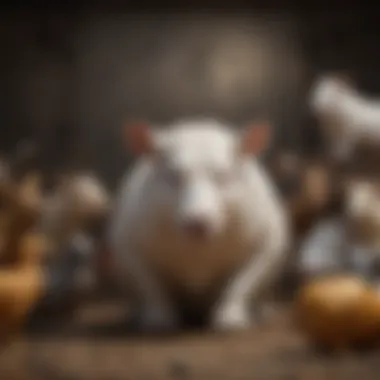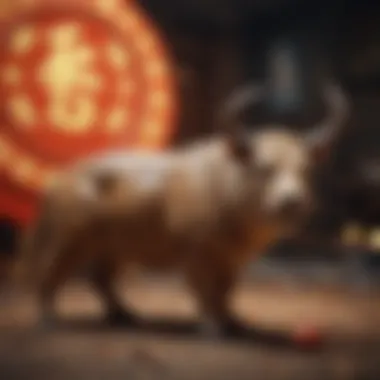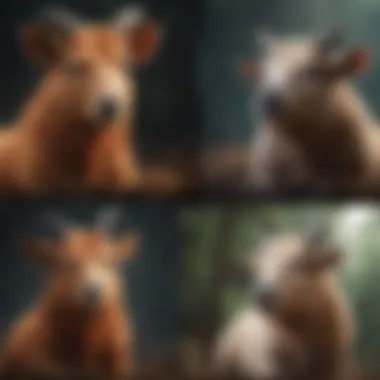Exploring Chinese Birth Animals: Culture and Symbolism


Intro
The Chinese birth animal is an intriguing aspect of Chinese culture, deeply embedded in the nation's history and traditions. It serves not only as a form of astrological identity but also as a framework through which individuals can better understand their personalities and relationships. Each of the twelve animals represents unique traits and characteristics, contributing to a rich tapestry of cultural significance. Understanding these animals encourages an exploration of individuality, societal roles, and even influences personal relationships. This article aims to navigate these complexities, examining the historical evolution, modern relevance, and the implications of birth animals in contemporary society.
Animal Profile
General Overview
The Chinese zodiac is a sequence of twelve animals, each linked to a lunar year. The cycle includes the Rat, Ox, Tiger, Rabbit, Dragon, Snake, Horse, Goat, Monkey, Rooster, Dog, and Pig. Each year is attributed to a specific animal, influencing those born during that time. In Chinese culture, these animals are not just symbols but reflect deep philosophical ideas and beliefs that have stood the test of time. They embody a variety of personality traits that are often used to predict one’s fate and experiences throughout life.
Habitat and Distribution
While the concept of birth animals exists within the realm of astrology, the animals themselves are rooted in the natural world. Most of them are found across various regions in Asia, embodying qualities that resonate with people's lives. For instance, the Dragon is often regarded as a powerful symbol, revered but mythical, whereas the Rat and Ox are more grounded in daily life. The distribution of these animals and their significance can vary significantly from one region to the next, leading to a diverse set of interpretations.
Fascinating Facts
Unique Traits and Adaptations
Each zodiac animal possesses distinct attributes that influence the personalities of those born under their auspices. For example, people born in the Year of the Rabbit are often considered gentle and kind, while those born in the Year of the Tiger are seen as brave and confident. These traits, deeply ingrained in the cultural narrative, shape the identity of individuals and their interactions with others.
Historical and Cultural Significance
The tradition of assigning birth animals dates back over 2,000 years, intertwining with confucian values, folklore, and religious beliefs. Chinese New Year marks the change of the zodiac, and is celebrated with various rituals and festivities. These customs serve as a reminder of the significance of birth animals and their role in society, bridging generational wisdom and modern practices.
Conservation Status
Current Population Trends
Since birth animals are not directly associated with a species needing conservation, this section might not apply. However, understanding the cultural significance helps protect traditions and practices that celebrate these symbols. The knowledge of the animals and their connections to astrology remains essential.
Threats and Challenges
The greatest challenge is the dilution of traditional practices in an increasingly modernized society. As globalization influences lifestyles, the deep connections to birth animals may weaken, risking the loss of an essential aspect of cultural identity.
Care Tips for Pet Owners
While not directly related to birth animals, individuals who value these symbols often have pets that share the same traits that their birth animal represents. Thus, understanding general care tips can enhance the experience for pet owners.
Basic Needs and Requirements
Owning a pet requires understanding its basic needs:
- Nutritious food appropriate for the species
- Regular veterinary check-ups
- Adequate exercise and social interaction
Health and Wellness Tips
Ensuring a pet's well-being is crucial. Pet owners should consider:
- Maintaining a balanced diet to promote well-being
- Providing mental stimulation to prevent boredom
- Creating a safe and loving environment
This approach not only nurtures pets but also fosters deeper connections reflecting the qualities of the owner’s birth animal.
Understanding the Chinese birth animal enriches not only personal identity but also relationships within society. As we explore these themes further, we reveal the profound impact these symbols have on our lives.
Preface to Chinese Birth Animals


Understanding Chinese birth animals is a significant aspect of Chinese astrology that influences personal identity and cultural narratives. These animals symbolize more than just years or periods; they encapsulate a variety of traits, beliefs, and values that have been passed down through generations. The twelve zodiac animals serve as a framework for interpreting behavior and relationships, making this system essential for grasping how individuals relate to themselves and others.
Overview of Chinese Zodiac
The Chinese Zodiac is based on a twelve-year cycle, with each year represented by an animal. These animals are Rat, Ox, Tiger, Rabbit, Dragon, Snake, Horse, Goat, Monkey, Rooster, Dog, and Pig. Each year, a new animal takes precedence, and people born in that year are believed to exhibit certain traits inspired by their corresponding animal. For instance, those born in the Year of the Dragon are often seen as charismatic and courageous, whereas those born in the Year of the Rabbit may be considered gentle and compassionate.
Being aware of one's birth animal provides insight into personal strengths and weaknesses. It contributes to a broader understanding of how astrology interacts with daily life in Chinese culture. This connection between birth animals and personal characteristics has led many to consult their zodiac when making important life decisions. Moreover, this practice illustrates the intricate relationship between individual identity and the broader cultural context in which one resides.
Historical Origins
The origins of the Chinese Zodiac can be traced back thousands of years to ancient Chinese civilization. There are various myths associated with the selection of the twelve animals. One popular story tells of a race organized by the Jade Emperor to determine the order in which creatures would be assigned a year. This legend signifies not only the interplay between fate and self-determination but also illustrates how narrative shapes cultural systems.
The historical development of the zodiac system further influences its contemporary applications. Originally, it was utilized for agricultural practices, helping farmers understand seasonal changes and timing for planting and harvesting. Over time, its significance extended beyond agriculture to encompass daily life, relationships, and personal development. This transition reflects societal changes and the lasting relevance of birth animals in understanding human behavior and relationships. Today, while some aspects of the zodiac are maintained as traditions, others have evolved to meet the needs of modern society.
Understanding the historical context and cultural implications of the Chinese Zodiac offers a deeper appreciation of its role in shaping personal identity and values in contemporary society.
The Twelve Animals of the Zodiac
The concept of the twelve animals in the Chinese zodiac is fundamental to understanding Chinese astrology and culture. Each animal symbolizes specific characteristics and influences, acting as a lens through which individuals can gain insight into their personal traits and life experiences. The relevance of these animals extends beyond mere symbolism; they are interwoven into various aspects of life, influencing decisions, personal identity, and social interactions. Knowing one's birth animal is often considered essential in navigating not only personal relationships but also career choices and lifestyle preferences.
Understanding the twelve zodiac animals provides a unique perspective on human behavior and cultural norms.
Rat
The Rat is the first animal in the Chinese zodiac cycle. It represents intelligence, resourcefulness, and adaptability. People born in the Year of the Rat are often seen as clever problem solvers. They can navigate challenges with ease and are known for their quick wit. However, this can sometimes lead to a tendency to be opportunistic, prioritizing personal gain over group harmony.
Ox
Following the Rat, the Ox symbolizes diligence, dependability, and strength. Individuals born in the Year of the Ox are often viewed as hardworking and reliable. They have a strong sense of responsibility, making them trustworthy companions and colleagues. Despite their calm nature, they can be quite stubborn, holding firmly to their beliefs and values.
Tiger
The Tiger is known for its bravery, confidence, and passion. Those born in the Year of the Tiger often possess a commanding presence and lead with enthusiasm. Their strong personality traits can make them both inspiring and intimidating. However, they should be mindful of impulsiveness, as their fierce nature can sometimes lead to rash decisions.
Rabbit
The Rabbit symbolizes peace, harmony, and sensitivity. People born under this sign are often gentle and kind-hearted. They adapt well to their surroundings and prefer avoiding conflict when possible. Their artistic talents shine through, and they often appreciate beauty in various forms. Nonetheless, they may struggle with decisiveness, as their diplomatic nature can delay important choices.
Dragon
The Dragon stands out in the zodiac for its unique position as the only mythical creature. It represents ambition, power, and charisma. Those born in the Year of the Dragon are usually seen as dynamic and energetic leaders. Their confidence attracts followers, but they can also risk being perceived as arrogant. Embracing humility can enhance their relationships with others.
Snake
The Snake is often associated with wisdom, intuition, and sophistication. Individuals born in this year are typically deep thinkers who approach life with discretion and insight. Their ability to analyze situations can lead to innovative solutions. However, their secretive nature may complicate relationships, as they can be perceived as untrustworthy.
Horse
The Horse symbolizes freedom, energy, and enthusiasm. People born in the Year of the Horse value independence and are fiercely determined. Their adventurous spirits often drive them to explore new horizons. While their optimism can uplift those around them, it is important for them to remain grounded and avoid overwhelming others with their intensity.
Goat
The Goat embodies creativity, compassion, and a strong sense of community. Those born under this sign are often gentle and nurturing, making them great friends and family members. Their artistic tendencies allow them to express themselves in meaningful ways. However, their sensitivity could lead to overthinking situations, which might cause unnecessary stress.
Monkey


The Monkey is characterized by cleverness, playfulness, and adaptability. Individuals born in the Year of the Monkey are typically lively and innovative. Their natural curiosity drives them to explore new ideas and experiences. However, they might face challenges with commitment, as their playful nature can lead to distraction in serious matters.
Rooster
The Rooster is known for its assertiveness, confidence, and punctuality. Those born in this year often possess strong leadership qualities, making them distinct in professional environments. Their keen attention to detail is beneficial, but it can also make them critical of others. Balancing their high standards with understanding can foster better relationships.
Dog
The Dog symbolizes loyalty, honesty, and a strong sense of justice. People born in the Year of the Dog are often regarded as faithful friends and reliable partners. Their commitment to righteousness often drives them to help others. However, their inclination towards idealism might sometimes lead to disappointment when reality does not meet their expectations.
Pig
Finally, the Pig represents generosity, kindness, and a love of life. Those born under this sign are often seen as tolerant and compassionate individuals. Their enjoyment of life is contagious, inspiring those around them. Nevertheless, they may struggle with materialistic tendencies, as their love for comfort can shift focus away from more significant personal growth.
Personality Traits Associated with Each Animal
Understanding personality traits linked to each of the twelve Chinese zodiac animals is essential in exploring how these animals influence individual behaviors and characteristics. Each animal embodies specific qualities that can provide insight into a person's nature, tendencies, and overall behavior. Recognizing these traits helps in grasping the broader impact the zodiac has on personal development and life choices.
Characteristics Overview
The twelve birth animals of the Chinese zodiac each represent distinct personality traits. Here is a brief overview:
- Rat: Intelligent, adaptable, and ambitious. Those born under this sign are often resourceful and quick-thinking.
- Ox: Diligent, dependable, and methodical. Ox individuals possess a strong sense of responsibility and perseverance.
- Tiger: Courageous, confident, and assertive. Tigers are known for their natural leadership abilities and passion for adventure.
- Rabbit: Gentle, compassionate, and diplomatic. Rabbits are often seen as sensitive and good-natured, valuing harmony.
- Dragon: Charismatic, enthusiastic, and strong-willed. Dragon-born individuals often exude confidence and energetic drive.
- Snake: Wise, intuitive, and secretive. Snakes are deep thinkers, often analyzing situations carefully before acting.
- Horse: Free-spirited, energetic, and intelligent. Horses have a love for freedom and adventure, often pursuing new experiences.
- Goat: Artistic, gentle, and kind. Goats are often seen as nurturing and compassionate, with a flair for creative expression.
- Monkey: Clever, playful, and curious. Monkeys are quick-witted, often using their intelligence to navigate challenges.
- Rooster: Observant, confident, and hardworking. Roosters are practical and often take on leadership roles.
- Dog: Loyal, honest, and protective. Dogs are known for their strong sense of duty and unwavering loyalty toward loved ones.
- Pig: Generous, compassionate, and diligent. Pigs are considered good-natured and enjoy helping others.
Each animal's traits can help individuals understand their strengths and weaknesses better.
Influence on Relationships
The zodiac animals not only play a role in shaping individual personalities but also influence interpersonal relationships. How people match with others based on their zodiac can impact compatibility.
For example, a Rat might be attracted to the strong, reliable qualities of an Ox, while a Horse could appreciate the adventurous spirit of a Tiger. However, mismatched signs can encounter conflict. A Rabbit may feel overwhelmed by the assertiveness of a Tiger, while a Snake might find the Horse's need for freedom challenging.
Additionally, understanding one’s birth animal can guide how one communicates and forms connections with others. People can benefit from recognizing the personality aspects of their friends and family through the lens of the zodiac, building stronger relationships based on mutual respect and understanding.
Cultural Significance of Birth Animals
The concept of birth animals holds profound cultural significance in Chinese society. It acts as a lens through which individuals can understand their place in the world. The twelve zodiac animals are not merely symbols; they encode various characteristics, traits, and their roles in personal relationships. Each animal connects to specific cultural beliefs and influences social behavior. This interconnection creates a rich tapestry that highlights how one’s birth animal can shape various life aspects.
Festivals around these birth animals embed them deeper into cultural practices. Celebratory events are aligned with the zodiac calendar, inviting communities to engage in customs that reflect millennia of tradition. These festivities foster a sense of belonging and continuity, reinforcing group identity. They encourage social interactions, allowing people to connect through shared beliefs and experiences.
In modern times, the relevance of birth animals evolves. There is a blending of traditions with contemporary views. People often incorporate elements into their lives, from personal branding to social media profiles. This adaptability showcases how birth animals are intertwined with identity, often guiding choices in matters like career and relationships.
Festivals and Celebrations
Ceremonies surrounding the zodiac animals are plentiful. Chinese New Year, for example, marks the beginning of a new zodiac cycle. It is a time for renewal and hope. Families come together, paying homage to their birth animals with various customs. One prevalent practice is the preparation of foods symbolizing good fortune, linked to specific animals.
- Lion dances are performed to ward off evil spirits and bring prosperity. Participants dress as lions, engaging in lively performances to celebrate the new year.
- Red envelopes filled with money symbolize good luck, often given during these festivities. Recipients are usually children or unmarried adults.
- The color red, associated with luck and happiness, is prevalent in decorations and clothing.
All these rituals create an atmosphere filled with joy and anticipation that strengthens community ties.
Modern Adaptations
Traditionally rooted practices are not static. In contemporary society, individuals reinterpret these customs. For example, online platforms facilitate discussions about zodiac traits, where users relate their personalities to their birth animals.
- Social media campaigns often highlight characteristics of each zodiac animal, promoting engagement through quizzes and posts about compatibility.
- Merchandise inspired by zodiac symbols is flourishing, allowing personal expressions tied to ancient beliefs.
- Birth animals serve as a topic of conversation, helping people explore their identities within social circles.


Such adaptations ensure that the relevance of birth animals is not lost in modernity but rather transformed, allowing fresh perspectives while honoring their historical roots.
Birth animals not only reflect personal traits but also bridge the past and the present, enriching cultural identity while adapting to contemporary life.
The Role of Birth Animals in Personal Identity
The role of birth animals in personal identity is significant and multi-faceted. It extends beyond mere astrological implications, delving into how individuals perceive themselves and their interactions with others. Understanding one’s birth animal provides a lens through which life choices and behaviors can be examined. This article highlights specific elements such as self-awareness and social dynamics that stem from zodiac interpretations.
Understanding Self through the Zodiac
The Chinese zodiac is a rich cultural artifact. Each of the twelve birth animals offers particular traits and tendencies that can help individuals understand themselves better. For example, someone born in the Year of the Dragon may identify with qualities of ambition and enthusiasm, while a Rat might feel a connection to adaptability and resourcefulness. These traits can shape self-image and motivations.
By reflecting on these characteristics, one can gain insights into personal strengths and areas for growth. This self-reflection fosters a deeper understanding of life events. When faced with challenges, knowing one's zodiac traits may guide decisions and enhance emotional resilience.
Moreover, the context of one's birth year also incorporates elements such as elements of water, fire, earth, metal, and wood. Each of these adds complexity to the personal identity. For example, a Wood Horse is different from a Metal Horse, affecting aspects like creativity and leadership styles. Therefore, the Chinese zodiac can be a useful tool for personal exploration and development.
Interactions with Others
Interactions and relationships can be profoundly influenced by one's birth animal. Understanding the zodiac traits of oneself and others can facilitate better communication. For instance, a person born under the Dog is often loyal and friendly, but may sometimes need assurance. Recognizing this can lead to more empathetic interactions.
Different zodiac animals also exhibit varying degrees of compatibility. Known as
Regional Variations in Understanding Birth Animals
Understanding the Chinese birth animals requires insight into how cultural interpretations vary across different regions. This article will focus on specific elements such as traditions, beliefs, and practices that offer depth on the relevance and importance of regional variations. Each community adds its unique flavor to a framework that is already rich in symbolism and heritage.
Differences Across Chinese Communities
Chinese communities around the world celebrate their birth animals with unique customs. While the fundamental meanings of the zodiac animals remain unchanged, localized interpretations create fascinating distinctions. For example, in mainland China, the festival of the Spring Festival includes elaborate performances such as lion dances. In contrast, communities in Taiwan might emphasize family reunions and ancestor worship during the new year celebrations.
Another aspect is the interpretation of personality traits associated with each birth animal. In southern China, the character of the Dragon is often seen as strong and dynamic. However, in northern regions, the same animal may be approached with caution, emphasizing wisdom over strength.
The regional customs result in festivals, rituals, and cultural symbols that highlight the birth animals. This illustrates how local traditions directly influence their significance and how individuals align their identities with these beliefs.
Global Perspectives
As Chinese culture spreads globally, the fascination with birth animals has crossed boundaries. In Western contexts, for instance, the Chinese zodiac has intrigued many, leading to discussions about its astrological impact on personalities. People often find themselves contemplating their birth animals during social gatherings, celebrating them alongside Western zodiac signs. This blending enriches cultural dialogue and presents opportunities to reevaluate personal identities across diverse frameworks.
Furthermore, countries with sizable Chinese populations, such as Singapore and Malaysia, embrace the zodiac with both fervor and adaptation. Local customs often incorporate Western elements, resulting in unique celebrations that differ from those in China. For instance, it is common for younger generations in these countries to participate in mixed cultural events that blend traditional Chinese rituals with modern festivities, creating a more inclusive environment.
Overall, as the understanding of birth animals evolves in different regions, it fosters broader conversations about identity, community, and cultural significance. People can gain a more nuanced understanding of themselves and others when engaging with such traditions, leading to deeper connections and cultural appreciation.
Ending: The Relevance of Birth Animals Today
The concept of birth animals holds significant relevance in today’s world. This traditional framework from Chinese astrology transcends mere superstition; it offers insights into personal identity, societal interaction, and cultural heritage. Understanding one's zodiac animal can provide a lens through which people view their relationships and behaviors, fostering a deeper comprehension of self and others.
Reflections on Cultural Heritage
The Chinese birth animal system reflects a rich cultural background. This zodiac is not just an astrological tool; it's a narrative steeped in history, connecting generations through shared beliefs and customs. Many Chinese families still observe zodiac-related customs during festivals such as the Lunar New Year. These celebrations reinforce family bonds and cultural pride, emphasizing the significance of one's birth animal.
Birth animals are a bridge between values and identity, anchoring individuals to their cultural roots.
In contemporary society, individuals often look to their birth animals as a means of self-identification. It’s common for people to share their zodiac signs in social settings, which can foster discussion and enhance community connections. This sharing can lead to an appreciation of differences as well as similarities among diverse groups.
Contemporary Observations
In today’s globalized world, the relevance of birth animals has expanded beyond China. People outside of Chinese communities are increasingly exploring these cultural symbols. This curiosity leads to a broader understanding of astrology and personality archetypes, which can offer valuable insights regardless of cultural background.
Furthermore, modern interpretations of birth animals often merge with contemporary practices. Some individuals utilize zodiac information for life decisions, such as career choices, relationship compatibility, and personal growth. These practices highlight the adaptive nature of ancient traditions, making them relevant in contemporary discussions about identity and connection.
As the world evolves, the exploration of Chinese birth animals offers a fascinating perspective. By understanding these cultural symbols, individuals can gain valuable insights into their lives and the society around them. The journey of the birth animal extends from the past into modern life, bridging historical context and present realities.















